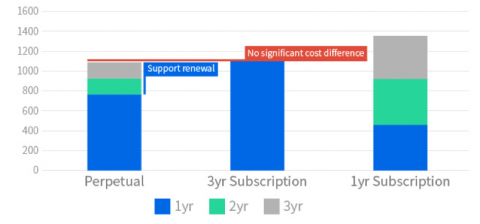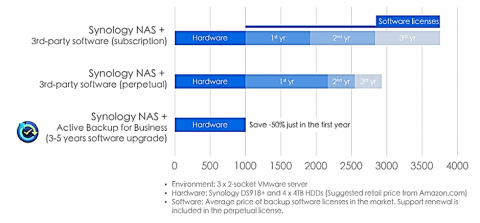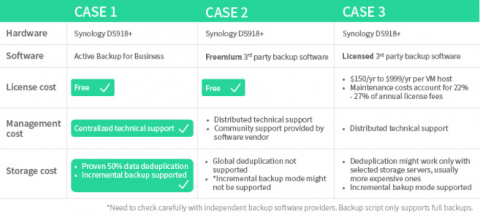

Have you been tasked with finding and comparing different backup solutions, only to become overwhelmed with various options, an avalanche of features, and abundant licensing models from the very start? If you’re looking for a backup solution, this article will hopefully give you some insight and help you steer clear of the potential pricing pitfalls.
To begin with, there are two types of business models in the backup market:
- Backup hardware and backup software sold separately
- All-in-one integrated backup appliance
For most companies, one of the major reasons they simply purchase backup software is to leverage their existing hardware. What they often overlook, though, is the software license fees associated with the total cost of ownership.
But wait, how expensive could a software license be, and what hidden costs should I be aware of?
Behind the scenes: hidden costs
Take VMware backup for example. Below are three common hidden costs that many organisations tend to overlook:
- Licensing and maintenance cost
In most VM backup cases, vendors typically take different approaches to how they charge, either per CPU socket or per VM host (system). Depending on your setup, a per host charge might not always be more expensive than per socket. For example, if you’re running services on a 2-socket VMware server at US$500 per socket, that’s going to cost more than US$800 for just the host itself. Based on this, it is important to consider the total cost rather than fixating on the initial price tag when comparing between vendors.

[Table I] How licensing models work in different use cases.
Aside from licensing fees, maintenance renewal costs for software updates, patches, and technical support shall also be taken into consideration. Do you know that cost of annual support renewals can account for 22 percent to 27 percent of the perpetual license cost? As the graph below shows, if we compare 3-year total cost on backup software, there’s almost NO cost difference between perpetual and subscription licenses after counting in support renewal costs.

[Table II] 3-year license cost: Subscription vs Perpetual
- Management Cost
When it comes to software management, since the integration of software and hardware involves two different companies with different support systems, businesses need to look at the software and hardware separately to figure out the root cause when a problem arises. For those who don’t have their own professional IT team, they often need to reach out to different vendors to go through the problems, which could often lead to wasted time and effort in the end.
- Storage Cost
The last thing to keep in mind is something we often neglect – the cost of hardware. Many businesses are limited by their budget, so they usually opt for freemium software. However, as the saying goes ‘there’s no such thing as a free lunch’, freemiums usually come with their own feature limitations, the major drawback of which would be to perform a FULL backup every time.
Take a simple scenario as an example – if you want to keep daily backups for 7 days, and the data size is 1TB with the average daily change rate at five percent, incremental backups could save 80 percent on storage as a result. By contrast, it’s very likely over 6x more space is wasted at the destination server compared with freemium software. Make sure the cost of hard drives and server hardware is also included, especially when you want to back up more complex business workloads.

[Table III] 7 days daily backup size: Full Backup vs Incremental Backup
It all adds up in the end
How about a backup solution that can help minimise all possible hidden costs?
From below comparison chart, the all-in-one, integrated, license-free backup solution can save more than 50 percent in just the first year alone. The cost savings can be even more significant when changing the backup storage servers to Dell EMC or HPE, or when larger business workloads back up is needed.

[Table IV] Cost of Backup Solution
Ultimately, with the same or even less money spent on backup software license for the first year, such a solution could be a desirable alternative for protecting business workloads on virtual machines, physical servers, Office 365 and G Suite.
You can further improve storage efficiency with global deduplication, which prevents redundant data when backing up from multiple devices.
For example, SHISEIDO saved 54 percent (28TB out of the total 58TB) storage usage with global deduplication in its business environment. Without this technology, it would have cost approximately $1,500 to store the extra 30TB of data on hard drives and expansion units.
Summary

[Table V] various attributes to several backup solutions in the market
Apart from the cost advantages, the all-in-one consolidated solution also integrates plenty of features a modern backup software offers. It allows users to manage backup tasks from one simple console and assure fast and reliable recovery.
Synology at a glance
Staying at the forefront of data management, Synology innovates and adapts to ever-evolving technologies, and continues bringing new possibilities to the table, including but not limited to solutions for data storage and backup, file collaboration, video management, and network infrastructure – all designed with one goal in mind – presenting a centralised platform to simplify IT administration while driving digital transformation for businesses worldwide.
For more information, kindly visit Synology Global Page





